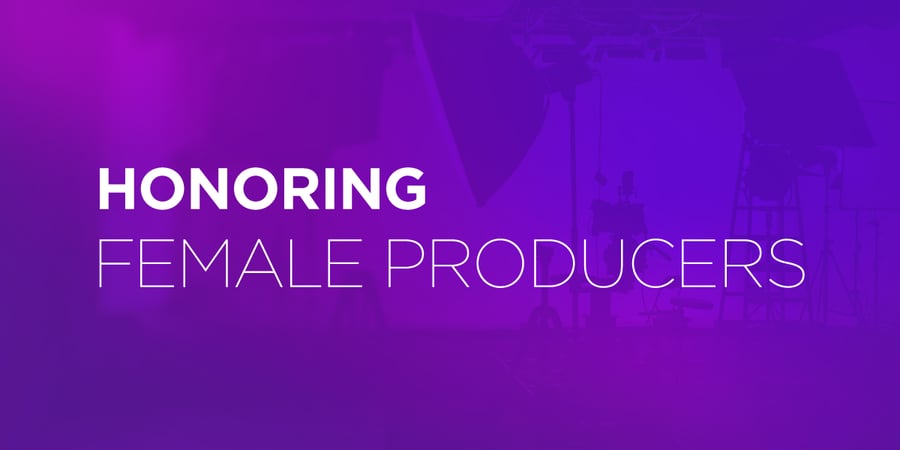Female Film Producers: Past & Present

A Brief History of Female Film Producers
Women have had a role in the business of production as long as movies have been made, but the prominence, available positions, and number of women in the field has varied wildly over the years.
Female film producers played a major role at the beginning of the film industry. Women dominated the field in the silent film era and outnumbered men by nearly 10 to 1. Never have the numbers been higher for women in the industry than during this era.
Alice Guy-Blaché was an early female film producer, releasing “La Fée aux Choux” in 1896. She experimented with color-tinting, sync sound, interracial casting, and special effects, and established women filmmakers as impressive creative forces in the industry. She also went on to operate her own studio, Solax Studios.
As the film industry grew, so did defining roles in production and the need for additional roles. In the early 1900s, the role of the producer became essential as budgets and cast sizes grew. Women were pivotal in both producer and director roles, handling the logistics, money, budget, and creative direction for many of the early silent films.
Lois Weber was another notable early female film producer. In 1916, she released the controversial movie “Where are My Children.” The controversy gave the film a life of its own and led to its massive success at the box office. The film is estimated to have made over $3 million in an era when tickets were $0.50.
As more money poured into the industry, smaller female-owned independent film companies were put out of business. At the same time, the industry moved to a more centralized model of production, with studios and men taking over the roles of director and producer. As studios unionized, most refused to accept female members, forcing women out of these roles and pushing many out of the industry.
In the 1940s and ‘50s, women played starring roles in front of the camera, but behind the camera, they were largely shut out from producer and director roles. Women continued to contribute more heavily in screenwriting and costume designing roles during this era.
In 1948, the Supreme Court ruled that the studios had become monopolies and that distribution needed to be handled outside of the studios. This created opportunities for independent distributors, independent theaters, and independent producers who could make films without a studio. This, unfortunately, also led to less stability and security in the industry, pushing out more women.
Through the 1960s, women's success was mainly in the set decor and costume design, things considered to be women’s skills at the time.
In the 1970s, the tide began to turn very slowly. In 1973, Julia Phillips won a Best Picture Oscar for producing “The Sting.” It was a defining moment for women in producer roles and other decision-making roles in the film industry as the glass ceiling began to break.
In the 1980s, women continued regaining ground as larger studios hired more women in major decision-making roles.
In the early 2000s, we began to see more female representation and more recognition of the representation. In 2002, Laura Ziskin became the first woman to produce the Oscars. In 2016, Jennifer Todd also produced the show.
There is still a serious under-representation of females in decision-making roles, and women are consistently not nominated for film producer or director roles despite films being worthy of recognition. Yet, there is more acceptance of women in decision-making roles, and positions of power. Reese Witherspoon’s Hello Sunshine is a great example of a female-led company that is changing the way women’s voices are heard in both film and TV production. Hello Sunshine’s focus is “to broaden perspective and empower women by giving them authorship, inspiring agency, and creating a platform to help them shape culture and the world around them.” We’re celebrating this Women’s History Month by highlighting client projects created by top female film producers, both up-and-coming filmmakers to watch and industry veterans.
10 of the Best Films by Women Producers
Oscar-winning “CODA”
Produced by: Sarah Borch-Jacobsen, Kristie Lutz, Valerie Garcia, and Marie de Cenival
Oscar-winning “Nomadland”
Produced by: Mollye Asher, Chloe Zhao, Taylor Shung, Frances McDormand, and Emily Jade Foley
Oscar-winning “Moonlight”
Produced by: Adele Romanski, Dede Gardner, and Veronika Nickel
“All the Beauty and the Bloodshed”
Produced by: Nan Goldin and Laura Poitras
“Carol”
Produced by: Christine Vachon, Elizabeth Karlsen, and Gwen Bialic
“Never Rarely Sometimes Always”
Produced by: Tatiana Brears, Lara Costa Calzado, Sara Murphy, and Adele Romanski
Produced by: Lynn Hendee, Alex Saks, and Julie Taymor
Produced by: Jody Klein
Produced by: Elle Fanning, Ally Israelson, and Paula Mazur
Produced by: Julia Pistor and Jennifer Teter
At GreenSlate, we are proud to support female film producers and women in all roles of production. From managing payroll to production accounting, our all-in-one app has all the features and tools productions need, from greenlight to delivery. Learn more about how our all-in-one app and industry-leading service can save you time on your next production.
Topics:
Client Projects
Related Posts
Access our blog for the inside scoop on what’s happening around the production office.
Get The Best of The Blog
Get the best of the GreenSlate blog once a month in your inbox by signing up for our GreenSlate Newsletter.
“If you're not using GreenSlate for processing production payroll, then you're not thinking clearly. We run about 10–12 productions a year and have used several of their competitors. I've put off sharing this as I've truly felt they've been a competitive advantage.”
Jeffrey Price
CFO at Swirl Films, LLC


.jpg?width=500&name=Sundance-Nominees-BLOG%20(1).jpg)
.jpg?width=500&name=GoldenGlobes2026%20(3).jpg)